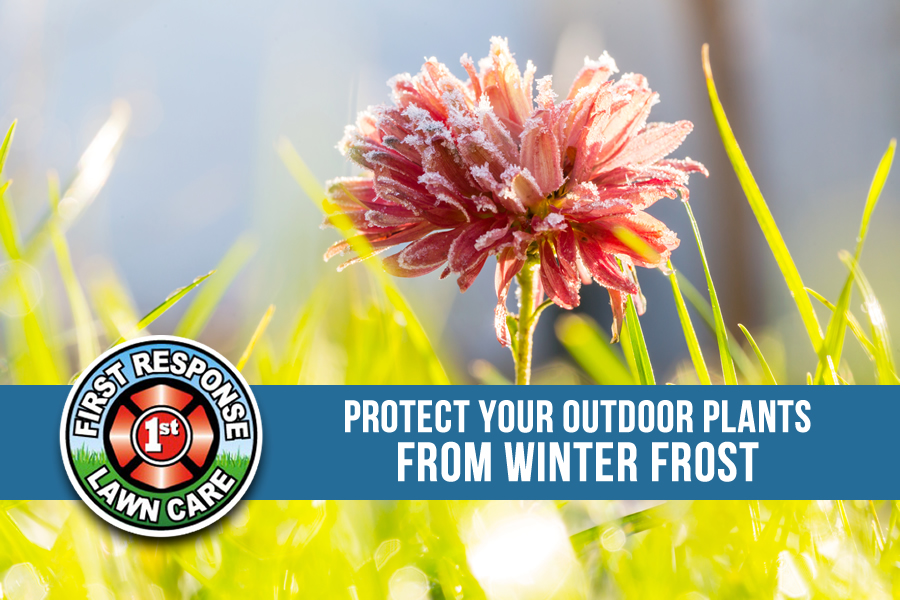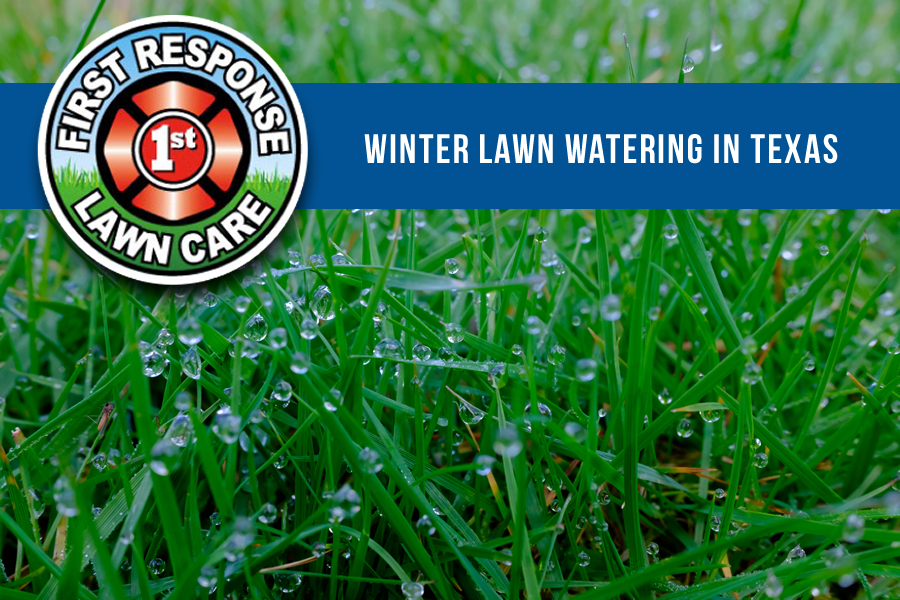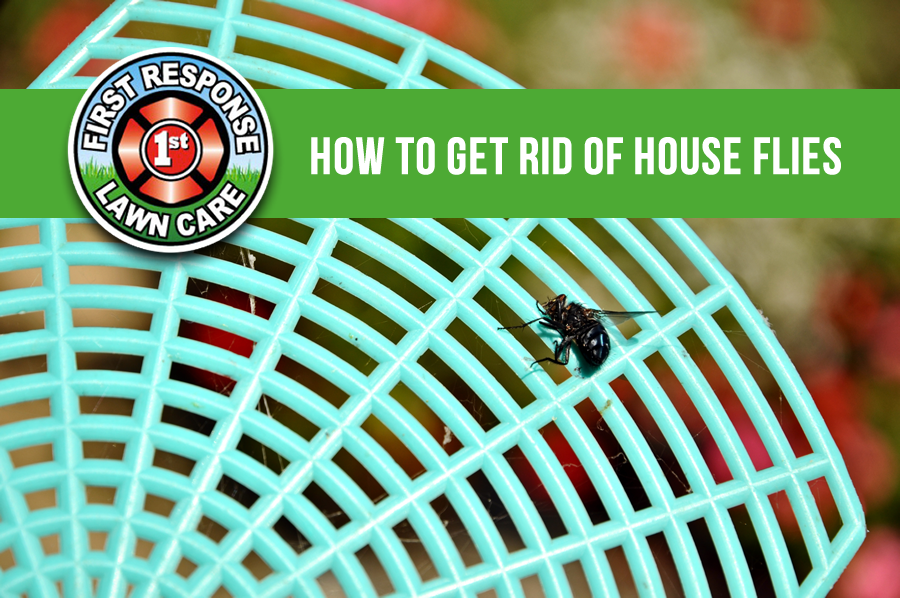
by admin | Feb 9, 2018 | Lawn Care 101
Low temperatures are being forecast for this weekend in much of Texas as a winter storm slides through the Dallas metro area. Time to talk about protecting outdoor plants from Texas frost. One day it’s 55 and sunny. The next, it’s 32 with frost on the ground. Welcome to Texas ya’all. Fluctuating temperatures are a common occurrence around here. Back to the pending freeze tomorrow. You may need to protect your outdoor plants and flowers from the freeze and/or frost.
The warmth we’ve had may be enough to keep a plant from freezing during a short cold snap. For added protection, you can protect plants in a freeze by placing a sheet or blanket over the plant and then putting a piece of plastic over the sheet or blanket to help keep warmth in. Never cover a plant with just plastic, however, as the plastic will damage the plant.
You can cover larger plants (trees and shrubs) with old bed sheets, burlap, or commercial frost cloths (avoid using plastic). For best results, drape the cover over a frame to keep it from touching the foliage.
Be sure to uncover them in the morning when the temperature rises above freezing.
Stay warm friends since the Groundhog Day rodent, Woodstock Willie, did see his shadow and predicted six more weeks of winter weather from February 2nd!

by admin | Jan 11, 2018 | Lawn Care 101, Lawn Maintenance Rockwall, Watering
The burning question this week is “Should I water my lawn in the winter”? And the answer is, “YES”! Your grass needs about 1 to 2 inches of water per week, including rainfall depending upon your type of grass.
During the periods of prolonged winter drought, if the air temperature is above freezing and the soil isn’t frozen, you should water every two or three weeks for 15 to 20 minutes – just enough to provide moisture to the crown and roots and counteract the drying effects of winter winds. Time afternoon watering so grass blades don’t remain moist overnight, which minimizes the threat of fungal diseases. If your grass is long and lush, you can try deep soaking. This allows the water to penetrate deep into the sub-soil and root zone of the grass, six inches deep. If you cut your lawn severely last fall or mow it in winter so that top growth is very short, it will dry out even faster. Even in winter, it’s best to leave your grass tall.
It’s also important to know your grass type. Cool season grasses like fescue, rye or even bluegrass do not necessarily go completely dormant during the winter months. It’s a good idea to water them every now and then when there is no forecast of a hard freeze. Texas generally has Bermuda, Zoysia, St. Augustine, and centipede grasses, which are warm-season grasses. These go dormant once temperatures drop below freezing. The combinations of warm and cool season grasses might include Bermuda and rye or Zoysia combined with fescue or rye. With all these combinations, the result is often the same – a two-tone lawn.

by admin | Oct 20, 2017 | Holiday Light Installation Rockwall
Brighten up your neighborhood by having a professional company install amazing lights and decorations. Let First Response Lawn care provide your holiday and Christmas lighting service this year. We can eliminate the time and expenses you spend dealing with outside Christmas decorations. Professional holiday lights and decoration services take a serious burden and potential hazard of falling off ladders and roofs for home owners preparing for the holidays.
We Make it Easy!
From rope lights to rooftop icicles, and net lighting to wreaths, we do everything for your outdoor holiday light display. Get your tree trunks wrapped with mini-lights? We’ve got you covered. Want a group of snow covered Christmas trees in your yard or in front of your restaurant? We can do it!
First Response Lawn Care handles residential and commercial lighting displays for the holidays. Call us today and let’s talk about how we can help make this holiday your brightest ever!
Call now to schedule your holiday lighting services (214) 701-7622.

by admin | Oct 13, 2017 | House Flies
With the cooler weather, we tend to leave the doors open more often. That invites the old house flies in and the annoying swatting begins. Flies can cause problems, especially when it comes to contaminating your food. While the average house fly does not bite people, it can spread disease and pathogens by laying eggs on your food and other surfaces. Get rid of flies by making a do-it-yourself trap using dish soap, making a do-it-yourself repellent using cayenne pepper or herbs like mint, or buying a commercial trap.
Keep in mind that preventing flies from coming into your home is just as important as removing them. You’ll need to be mindful of leaving doors or windows without screens open. Check your sealing and insulation. Doors and windows should be closed and sealed to prevent flies and other insects from coming in.
So we are addressing what happens once the pests have made their way in your home. You’ll need to make the area seem less appealing as a potential food or housing source. Here are our top 5 tips:
Set a trap with dish soap. Pour 1 inch (2.54 cm) of liquid dish soap into a jar and add 1 inch (2.54 cm) of water. The flies will be attracted to the soap and drown in the water.
- Use fruit flavored dish soap for best results. An apple scented soap or lemon soap may provide better results, for example.
- Add a drop or two of apple cider vinegar if you do not seem to be catching many flies. The vinegar will attract flies to the jar.
Mix a natural fly repellent in a spray bottle. Flies will stay away from the scent of cayenne pepper. Mix a little in a spray bottle with water.
- Spray the cayenne mixture in doorways, window sills and other cracks and corners where flies might try to come in. The smell of the cayenne will keep them out.
Plant herbs to repel flies. They do not like scents such as lavender, basil and mint. Set up an herb garden in your kitchen or window sills to keep flies out.
- Use marigolds if you prefer flowers to herbs. Marigolds are offensive to flies.
Outsmart flies with plastic bags full of water. The way the bags and water reflect light will resemble a spider’s web, and flies always try to avoid those.
- Fill clear plastic bags halfway with water. Seal the bags and hang them near doors and windows.
- Hang old CDs and DVDs to achieve the same light effect.
Purchase flypaper. This can be found at hardware stores, department stores and home improvement retailers. Flies will stick to the paper and be unable to fly away.
- Remove the flypaper and discard it when too many flies begin to accumulate. Not only will it cease to be useful, a crowded strip of flypaper often looks unattractive.
Consider a fly light. You can buy a special light that keeps flies away from your kitchen or home. Many restaurants use this type of device.
Throw out fruits and vegetables before they get too old to eat. Whenever possible, keep them in the refrigerator instead of out in the kitchen.
Keep all of your trash sealed. Flies are attracted to garbage, especially any decaying food.
Clean your floors, countertops and other surfaces thoroughly. Be sure not to leave crumbs or spills.
You could buy a venus fly trap plant.
Happy fly trapping!

by admin | Sep 29, 2017 | Fall Vegetable Garden Prep
We celebrated our first day of Fall on September 22nd. Now it’s time to think about prepping our veggie beds for Fall as the temperatures begin to cool down. It’s best to prepare your soil in the Fall while the earth is still warm and workable. There are just a few simple steps to Fall soil preparation:
WEEDING
Now is the time to dig out the roots of problem weeds like wild morning glory, oxalis, nut sedge and Bermuda grass. Be sure to remove any others with seed still on the plant. If shed, this seed can easily winter over in the soil to infest the new year’s bed. It’s a common occurrence in spring prepped soils to find weed populations increasing with each new season.
FEEDING
Spread amendments evenly over the area before you till. You’ll need a lot of manure and/or compost to feed microorganisms and help the soil remain open and well-drained. Then boost fertility with materials such as bone meal for nitrogen and rock phosphate for phosphorous. An easy way to achieve this is to buy a complete organic fertilizer in pellet or granular form, which is easy to transport and apply.
TILLING
Fall tilling is all about opening up the soil to incorporate nourishment, relieve compaction, increase oxygen and improve drainage. The deeper you get, the better. Because you’re not planting right away, it’s best to rough till once in each direction. This leaves the surface irregular with large chunks of earth. The clods will gradually erode over the course of the winter, carrying amendments deeper down with the runoff. You can spread the entire surface with mulch or shredded leaves to prevent erosion. The ground will flatten out considerably by spring when you’ll need only fine till to prepare for planting.
Come spring 2018, you’ll be pleasantly surprised how much easier it will be to put the garden in without all that hauling, spreading and tilling.





